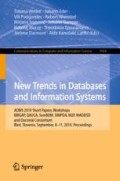Abstract
Model-based systems engineering (MBSE) focuses on creating and exploiting multiple related models that help define, design, and document a system under development. The principal question about this approach concerns the level of association between these models. As our goal is a modeling of a system, we can assume that multiple models will form a tightly coupled suite, but in practice, partial models usually form a loosely bounded model kit. In this research we discuss two notions: model suite and model set, give them characterization based on mathematical theory.
The work was done within the framework of the state assignment (research topic: 065-2019-0014 (reg. no. AAAA-A19-119011590097-1).
Access this chapter
Tax calculation will be finalised at checkout
Purchases are for personal use only
References
Thalheim, B.: The conceptual framework to multi-layered database modelling. In: Frontiers in Artificial Intelligence and Applications, EJC, Proc. Maribor, Slovenia, vol. 206, pp. 118–138 (2010)
Thalheim, B., Tropmann-Frick, M.: Models and their capability. In: Computational Models of Rationality, vol. 29, pp. 34–56 (2016)
Fisher, A., Friedenthal, S., Sampson, M., et al.: Model lifecycle management for MBSE. In: NCOSE International Symposium. Las Vegas, NV, vol. 24, pp. 207–229 (2014)
Atkin, A.: Peirce’s Theory of Signs. The Stanford Encyclopedia of Philosophy (2013)
Harel, D., Rumpe, B.: Modeling Languages: Syntax, Semantics and All That Stuff, Part I: The Basic Stuff, Weizmann Science Press of Israel©, Jerusalem, Israel, Technical Report 2000, pp. 1–28 (2000)
Schreider, Y., Sharov, A.: Systems and Models. In Russian ed. 152 pp. Radio & Sviaz, Moscow (1982)
Schreider, Y.: Logika znakovyh system, p. 64. Znanie, Moscow (1974)
Chandler, D.: Semiotics for Beginners, p. 310. Routledge, Abingdon (2007)
Mal’cev, A.: Algebraic Systems, p. 315. Springer, Heidelberg (1973). https://doi.org/10.1007/978-3-642-65374-2
Gurr, C.: On the isomorphism, or lack of it, of representations. In: Marriott, K., Meyer, B. (eds.) Visual Language Theory, pp. 293–305. Springer, Heidelberg (1998). https://doi.org/10.1007/978-1-4612-1676-6_10
Gastev, Y.: Homorfizmy i modeli (in Russian), p. 152. Nauka, Moscow (1975)
Thalheim, B.: Towards a theory of conceptual modelling. J. Univ. Comput. Sci. 16(20), 3102–3137 (2010)
Burton-Jones, A., Weber, R.: Building conceptual modeling on the foundation of ontology. In: Computing Handbook, Third edn. Computer Science and Software Engineering, pp. 1–15. Chapman and Hall (2014)
Rosemann, M., Green, P., Indulska, M., Recker, J.: Using ontology for the representational analysis of process modelling techniques. Int. J. Bus. Process Integr. Manag. 4(4), 251–265 (2009)
Baader, F., Ghilardi, S.: Connecting many-sorted theories. J. Symb. Logic 72(2), 535–583 (2007)
Thalheim, B.: Model adequacy. In: MOD-WS 2018 Workshops at Modellierung 2018. Braunschweig, Germany (2018)
Marca, D., McGowan, C.: SADT: Structured Analysis and Design Technique, p. 392. McGraw-Hill, New York (1988)
Dahanayake, A., Thalheim, B.: Co-evolution of (information) system models. In: Bider, I., et al. (eds.) BPMDS/EMMSAD -2010. LNBIP, vol. 50, pp. 314–326. Springer, Heidelberg (2010). https://doi.org/10.1007/978-3-642-13051-9_26
Vernadat, F.: Enterprise Integration: On Business Process and Enterprise Activity Modeling (1996)
Zachman, J.: The Zachman Framework: A Primer for Enterprise Engineering and Manufacturing. Zachman International (2003)
Software AG. Methods ARIS 7.0. Darmstadt (2011)
Curtis, B., Kellner, M., Over, J.: Process modeling. Commun. ACM 35(9), 75–90 (1992)
Goguen, J., Burstall, R.: Institutions: abstract model theory for specification and programming . J. Assoc. Comput. Mach. 39(1), 95–146 (1992)
Author information
Authors and Affiliations
Corresponding author
Editor information
Editors and Affiliations
Rights and permissions
Copyright information
© 2019 Springer Nature Switzerland AG
About this paper
Cite this paper
Fiodorov, I., Sotnikov, A. (2019). Model Suite and Model Set in Software Development. In: Welzer, T., et al. New Trends in Databases and Information Systems. ADBIS 2019. Communications in Computer and Information Science, vol 1064. Springer, Cham. https://doi.org/10.1007/978-3-030-30278-8_27
Download citation
DOI: https://doi.org/10.1007/978-3-030-30278-8_27
Published:
Publisher Name: Springer, Cham
Print ISBN: 978-3-030-30277-1
Online ISBN: 978-3-030-30278-8
eBook Packages: Computer ScienceComputer Science (R0)

